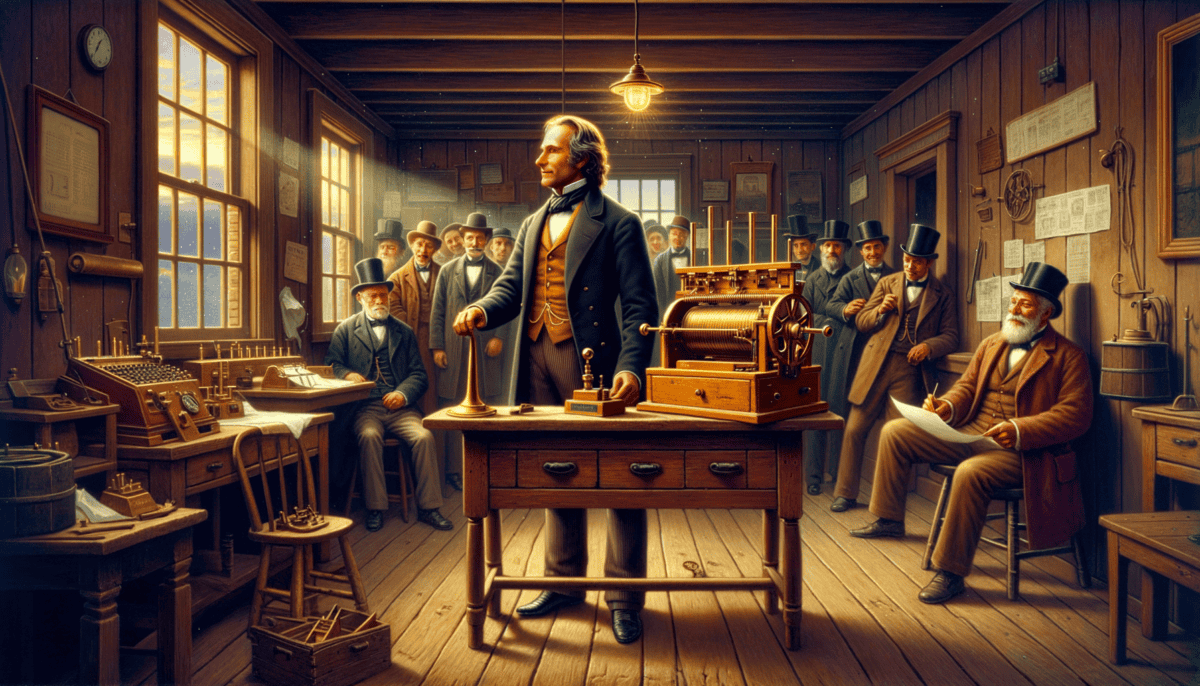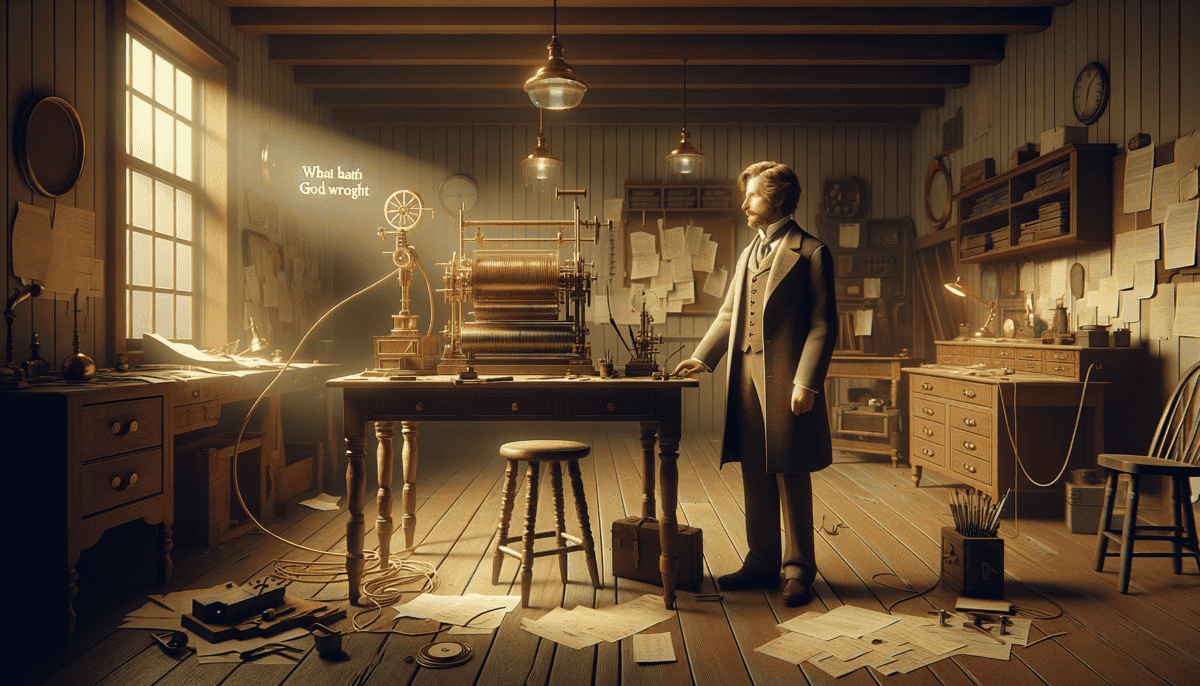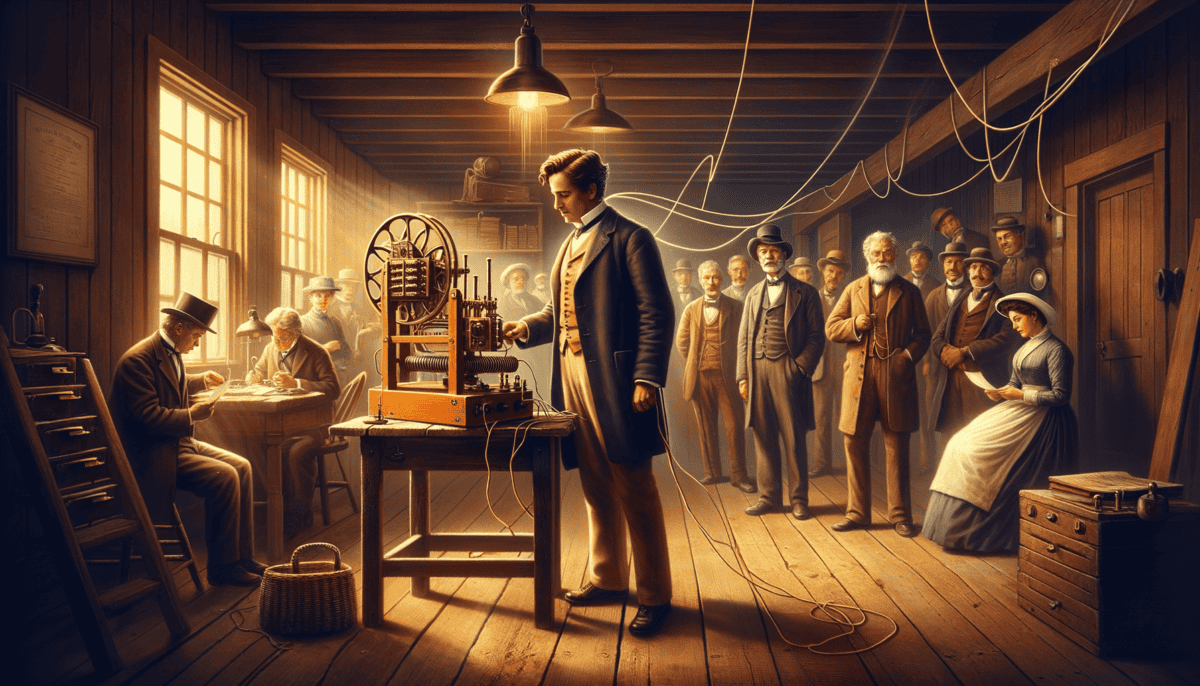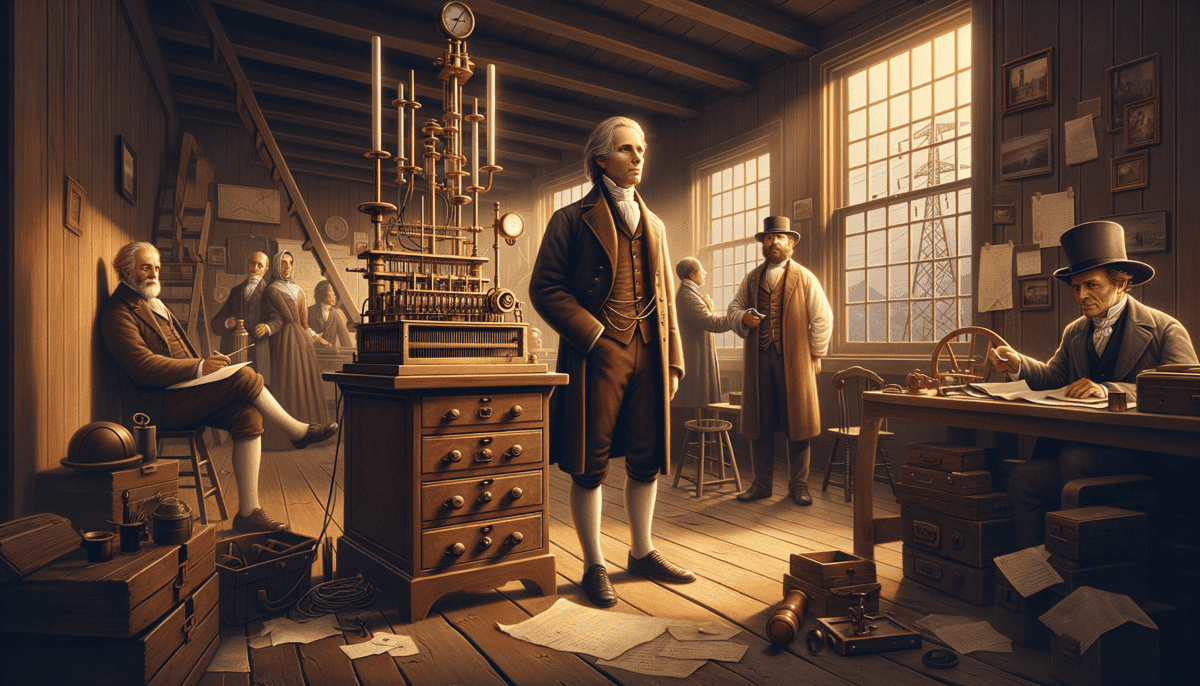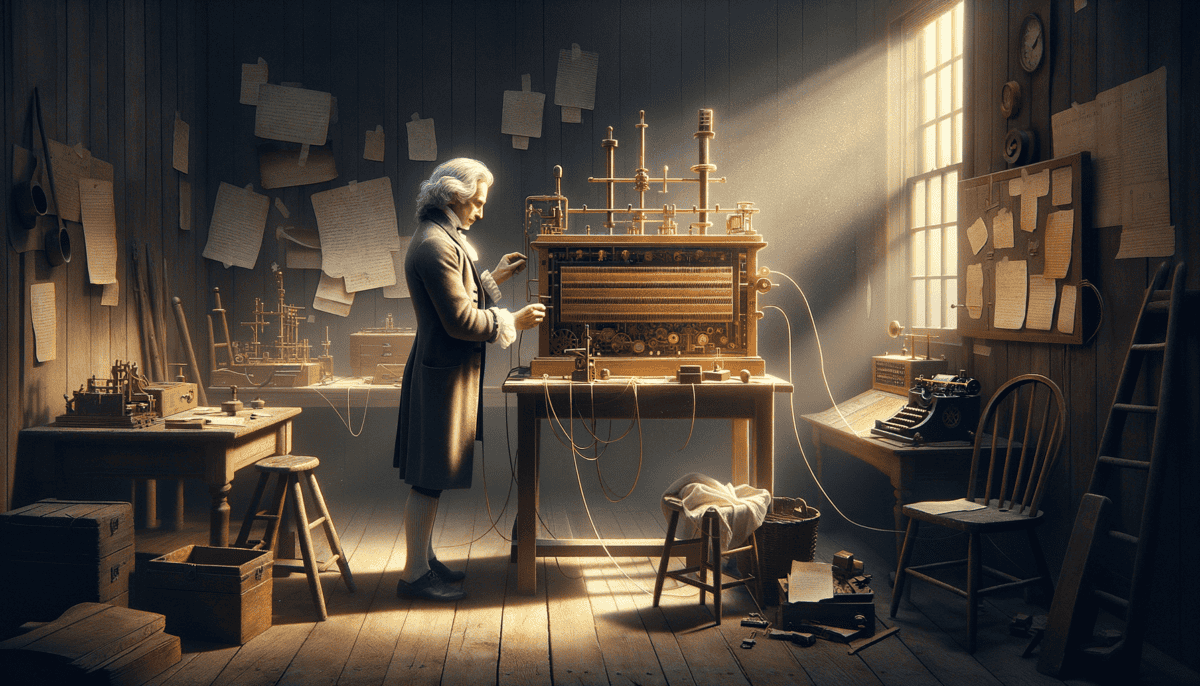The Artist’s Brush
Samuel Morse stood in front of a big canvas. His paintbrush moved slowly, adding colors to a picture of a man. The man in the painting was important. He was a hero named Lafayette.
Samuel loved to paint. He spent many hours making beautiful pictures. People said he was very good at it. But Samuel didn’t know that his life was about to change.
A Day of Good News
One day, Samuel got a letter. It said his wife was sick. He was worried and wanted to go home right away. But home was far away. It would take many days to get there.
Samuel thought, “If only there was a way to send messages faster!”
Think About It
How do you feel when you can’t talk to someone you love right away?
A Sad Journey
Samuel packed his bags and started his long trip home. He traveled for many days. He was worried about his wife the whole time.
When he finally got home, he had a big shock. His wife had already died. Samuel was very sad. He wished he could have been there sooner.
A New Idea
This sad event made Samuel think. He thought about how slow messages were. He wondered if there was a way to make them faster.
Samuel started to imagine a new kind of message. It would be like lightning, very fast! But how could he make it work?
From Paint to Wires
Samuel didn’t stop painting right away. But he started to think about other things too. He read books about electricity. He talked to smart people who knew about science.
One day, while on a ship, Samuel had a big idea. He drew a picture of a machine. This machine could send messages very fast, using electricity!
“If electricity can go over any length of wire, why can’t messages be sent this way?” Samuel thought.
A New Adventure Begins
Samuel was excited about his new idea. He wanted to make it real. But he didn’t know how hard it would be.
He started to work on his idea. Sometimes, he would forget to eat or sleep. His friends thought he was silly. They said, “Why don’t you just keep painting?”
But Samuel didn’t give up. He knew his idea was important. He said, “This machine will change the world!”
Learning New Things
Samuel had to learn a lot of new things. He didn’t know much about electricity or machines. But he was good at learning.
- He read many books
- He asked questions to smart people
- He tried many experiments
Sometimes, his experiments didn’t work. But Samuel kept trying. He knew that every mistake taught him something new.
A Big Decision
One day, Samuel had to make a big choice. Should he keep painting or work on his new idea?
He loved painting. It was what he knew best. But his new idea was exciting. It could help many people.
After thinking for a long time, Samuel made his choice. He would work on his new idea. He would try to make messages go as fast as lightning!
The Start of Something Big
Samuel didn’t know it yet, but his choice would change the world. His idea would grow into something amazing. It would help people talk to each other from far away.
But right now, it was just a dream. Samuel had a lot of work to do. He needed to turn his idea into something real.
As he put down his paintbrush, Samuel felt excited. A new adventure was starting. He was ready to face any challenge that came his way.
Quick Quiz
1. What was Samuel’s job at the start of the story?
2. What sad thing happened to Samuel?
3. What new idea did Samuel have?
A Spark of Inspiration
Samuel Morse woke up early. His mind was buzzing with ideas. He couldn’t wait to start working on his new invention.
The Big Idea
Samuel’s idea was simple but amazing. He wanted to send messages through wires, using electricity. It would be much faster than sending letters.
He called his invention the “telegraph.” It was a big word that meant “far writing.”
Early Experiments
Samuel started doing experiments in his workshop. He had wires, batteries, and many tools. Sometimes, things didn’t work the way he wanted.
One day, a spark jumped from one wire to another. Samuel got excited. He thought, “Maybe this is how messages can travel!”
Fun Fact
The word “telegraph” comes from two Greek words: “tele” meaning “far” and “graphein” meaning “to write.”
Facing Challenges
Samuel faced many problems. Here are some of them:
- The wires didn’t work well
- The batteries were too weak
- He didn’t know how to make the messages clear
But Samuel didn’t give up. He kept trying new things every day.
A Lucky Meeting
One day, Samuel met a young man named Alfred Vail. Alfred was very interested in Samuel’s ideas.
They talked for hours about the telegraph. Alfred had some great ideas too!
Samuel asked, “Would you like to work with me on this?”
Alfred smiled and said, “Yes! I’d love to!”
Working Together
Samuel and Alfred made a great team. They worked hard every day. They tried new things and solved problems together.
Alfred was good at making things. He helped build better parts for the telegraph. Samuel was good at thinking of new ideas. Together, they made the telegraph better and better.
A Big Test
After many months of work, Samuel and Alfred were ready for a big test. They set up their telegraph in two rooms.
Samuel went to one room. Alfred went to the other. They were going to try to send a message!
Samuel pressed a button. In the other room, Alfred heard a click. It worked! They had sent a simple message through wires!
Excitement and Doubt
Samuel and Alfred were very happy. Their hard work was paying off. But not everyone believed in their invention.
Some people said, “It’s just a trick. It won’t work for long messages.”
Others said, “Why do we need this? Letters work just fine.”
But Samuel and Alfred didn’t listen to the doubters. They knew their invention was important.
Planning for the Future
Samuel and Alfred started to think big. They wanted to send messages between cities, not just rooms.
They made a plan:
- Improve the telegraph machine
- Find a way to send messages over long wires
- Show people how useful the telegraph could be
- Get money to build telegraph lines
It was a big plan, but they were ready for the challenge.
A New Language
Samuel realized they needed a special way to send messages. He started working on a code. It would use dots and dashes to represent letters.
This code would later be called “Morse Code.” It was like a secret language for the telegraph!
Growing Excitement
As Samuel and Alfred kept working, more people got interested. Some scientists came to see the telegraph. They were amazed!
One scientist said, “This could change the world!”
Samuel and Alfred felt proud. Their hard work was being noticed.
Looking Ahead
Samuel and Alfred knew they still had a lot of work to do. But they were excited about the future.
Samuel said, “One day, people all over the world will use our invention to talk to each other!”
Alfred nodded and replied, “And we’ll be the ones who made it happen!”
Family Challenge
Try making your own simple code! Use dots and dashes to represent letters. Then, send secret messages to each other!
As the sun set, Samuel and Alfred went back to work. They knew that tomorrow would bring new challenges and new ideas. The telegraph was just the beginning of their amazing journey.
Tinkering and Trials
Samuel Morse and Alfred Vail were busy in their workshop. They had a big job to do. They needed to make the telegraph work better.
Building the Prototype
Samuel and Alfred worked on making a model of the telegraph. This model was called a prototype. It wasn’t perfect, but it helped them test their ideas.
They used many things to build it:
- Wires
- Batteries
- Magnets
- Wood
- Metal parts
Every day, they tried new ways to make the telegraph send clearer messages.
Solving Problems
Making the telegraph work wasn’t easy. Samuel and Alfred faced many problems. Here are some of the big ones:
- The signal got weaker over long wires
- Sometimes, the message got mixed up
- The battery didn’t last long enough
- The machine was too big and heavy
But they didn’t give up. They kept trying new ideas.
A Breakthrough
One day, Alfred had a great idea. He made a new part for the telegraph. It was called a “relay.”
The relay helped make the signal stronger. Now, they could send messages over longer wires!
Samuel was very happy. He said, “Alfred, this is amazing! You’ve solved a big problem!”
Showing the World
Samuel and Alfred were excited to show their invention to other people. They set up a demonstration at a university.
Many scientists came to see the telegraph. Some were impressed. Others were not sure.
Think About It
How would you feel if you showed your invention to a group of experts? Would you be nervous or excited?
Doubts and Questions
Not everyone believed in the telegraph. Some scientists had many questions:
“How can you send messages through wires?”
“Won’t the messages get mixed up?”
“Is it safe to use electricity like this?”
Samuel and Alfred answered all the questions. They showed how the telegraph worked. Some people started to believe in their invention.
Making It Better
Samuel and Alfred listened to what people said. They used the feedback to make the telegraph better.
They made the machine smaller and easier to use. They improved the code to send clearer messages.
A Race Against Time
Samuel and Alfred weren’t the only ones working on a telegraph. Other inventors were trying to make one too.
They knew they had to work fast. They wanted to be the first to make a working telegraph.
Testing, Testing
Samuel and Alfred did many tests. They wanted to make sure the telegraph worked well.
Here’s what they did:
Telegraph Testing Steps
Send short messages
Send long messages
Test different types of wire
Try different batteries
Send messages at different times of day
A Big Decision
After all their hard work, Samuel and Alfred had to make a big choice. Should they keep working on the telegraph? Or should they give up?
They talked about it for a long time. In the end, they decided to keep going.
Alfred said, “We’ve come too far to stop now.”
Samuel nodded, “You’re right. Our telegraph will change the world. We can’t give up.”
Looking to the Future
Samuel and Alfred knew they still had a lot of work to do. But they were excited about what was to come.
They dreamed of a day when people could send messages across the whole country. Maybe even across the ocean!
As they worked, they imagined all the ways the telegraph could help people:
- Families could talk to each other from far away
- News could travel faster
- Businesses could work better
- It could even save lives in emergencies
The Next Step
Samuel and Alfred knew what they had to do next. They needed to get money to build more telegraphs. They also needed to show more people how great their invention was.
It would be hard work. But they were ready for the challenge.
As they left the workshop that night, Samuel said, “Tomorrow, we’ll start planning our next big test. We’ll show everyone that the telegraph is real and it works!”
Alfred smiled and replied, “I can’t wait. The world isn’t ready for what we’re about to do!”
Family Challenge
Try sending messages without talking! Use hand signals or write notes. How does it feel to communicate in a new way?
Samuel and Alfred went home, tired but happy. They knew that tomorrow would bring new challenges. But they were ready to face them together. The telegraph was getting better every day, and soon, it would change the world!
The Race for Patents
Samuel Morse and Alfred Vail were not alone. Other smart people were also trying to make telegraphs. It was like a big race!
The Other Inventors
Many inventors wanted to be the first to make a working telegraph. Some of them were:
- William Cooke
- Charles Wheatstone
- Joseph Henry
These men had their own ideas about how to send messages with electricity.
Different Designs
Each inventor had a special way of making their telegraph. Some used needles that moved. Others used bells that rang. Morse and Vail’s telegraph made marks on paper.
Quick Quiz
Q: What did Morse and Vail’s telegraph do?
A: It made marks on paper!
The Money Problem
Making telegraphs cost a lot of money. Morse and Vail needed help to pay for their work. They asked many people for money, but it wasn’t easy.
Morse said to Vail, “We must keep trying. Our telegraph is special!”
Vail nodded, “You’re right. We can’t give up now.”
Showing Off the Telegraph
Morse and Vail knew they had to show people how great their telegraph was. They did many tests to prove it worked.
Here’s what they did:
- They sent messages in a room
- Then they sent messages between buildings
- Next, they tried sending messages across town
- Finally, they sent messages between cities
People were amazed! They had never seen anything like it before.
The Big Fight
All the inventors wanted to say, “I made the telegraph first!” They needed something called a patent. A patent is like a special paper that says an invention belongs to you.
Morse and Vail worked hard to get their patent. They had to:
Steps to Get a Patent
Write down how the telegraph works
Draw pictures of the telegraph
Show that their idea was new
Pay money to the patent office
Wait for the patent office to say yes
A Close Call
One day, Morse got some bad news. Another inventor named Charles Jackson said he had the idea for the telegraph first!
Morse was worried. He told Vail, “We must prove that our telegraph is different and better.”
They worked day and night to show how special their telegraph was.
Good News at Last
After a long time, Morse and Vail got good news. They got their patent! It was a happy day.
Morse smiled and said, “Now we can show the world our telegraph without worry!”
The Big Plan
Morse and Vail knew they had more work to do. They wanted to build telegraph lines all over the country. But they needed help from important people.
They made a plan:
“We will go to Washington D.C. We will show our telegraph to the government. They will see how great it is and help us build it everywhere!”
Getting Ready
Morse and Vail packed up their telegraph. They practiced sending messages. They wanted everything to be perfect for their big show in Washington.
As they got ready, Morse said, “Alfred, this is our chance to change the world. Are you ready?”
Vail nodded, “I’m ready. Let’s show them what we can do!”
The Journey Begins
Morse and Vail set off for Washington D.C. They were excited and a little nervous. They knew this trip could change everything.
On the way, they imagined how their telegraph could help people:
- News could travel fast
- Families could talk even when far apart
- Trains could run more safely
- The whole world could be connected
A New Chapter
As Morse and Vail arrived in Washington, they knew they were starting a new part of their story. They had worked hard and never gave up. Now, they were ready to show the world what they had made.
Morse looked at the city ahead and said, “Alfred, no matter what happens, we’ve come so far. I’m proud of what we’ve done.”
Vail smiled and replied, “So am I, Samuel. So am I. Now, let’s go make history!”
Think About It
How do you think Morse and Vail felt as they arrived in Washington? Excited? Scared? Both? Why?
As they walked into the city, Morse and Vail knew that tomorrow would bring new challenges. But they were ready to face them together. Their telegraph was about to meet its biggest test yet!
A Language of Dots and Dashes
Morse and Vail arrived in Washington D.C. with big hopes. They knew their telegraph was special, but it needed something more. It needed a special language.
The Birth of Morse Code
Morse had an idea. He said to Vail, “What if we use dots and dashes to make letters?”
Vail’s eyes lit up. “That’s brilliant, Samuel! Let’s try it!”
They worked day and night to make a code. Each letter would have its own pattern of dots and dashes.
Morse Code Basics
• Short sound = Dot (•)
• Long sound = Dash (−)
Example: SOS = • • • − − − • • •
Learning the New Language
Now they had to teach others how to use Morse code. It wasn’t easy!
- First, they taught their helpers
- Then, they taught some curious visitors
- Soon, they were teaching anyone who wanted to learn
People found it hard at first, but they got better with practice.
The First Messages
Morse and Vail sent their first real messages using the new code. It was exciting!
“This is amazing!” Vail tapped out.
“We’re making history,” Morse replied.
Showing Off to the Public
It was time to show everyone how great the telegraph and Morse code were. Morse and Vail set up big demonstrations.
Here’s what happened:
- They invited lots of people
- They explained how the telegraph worked
- They sent messages in front of everyone
- People were amazed!
Growing Interest
More and more people wanted to see the telegraph. Newspapers wrote about it. Important people came to watch.
One day, a man asked, “Can you send a message to my friend in Baltimore?”
Morse smiled and said, “Not yet, but soon we will!”
The Big Dream
Morse and Vail had a big dream. They wanted to build telegraph lines all across America. But they needed help.
The Telegraph Dream
Build lines between cities
Connect the whole country
Send messages fast and far
Change how people talk to each other
Talking to Congress
Morse knew he had to talk to Congress. These were the people who could help make the dream come true.
He practiced what he would say:
“Imagine a world where news travels in minutes, not days. Where families far apart can talk quickly. This is what the telegraph can do!”
The Big Test
Congress wanted to see the telegraph work. They set up a big test.
Morse was nervous but excited. He told Vail, “This is our chance. Let’s show them what we can do!”
A Successful Show
The day of the test came. Morse and Vail were ready.
They sent messages back and forth. The Congress members watched in awe.
One of them said, “This is incredible! It’s like magic!”
Teaching Morse Code
After the test, many people wanted to learn Morse code. Morse and Vail became teachers.
They made simple charts to help people learn. Soon, more and more people could send messages.
The World Takes Notice
News of the telegraph spread far and wide. People from other countries wanted to know more.
Morse got letters from England, France, and even Russia!
A New Way to Talk
People started to see how the telegraph could change everything. It was faster than any other way to send messages.
How Fast Is the Telegraph?
• Horse rider: 10 miles per hour
• Train: 50 miles per hour
• Telegraph: Almost instant!
Dreams of the Future
Morse and Vail often talked about the future. They imagined a world connected by telegraph wires.
Vail said, “One day, people might even send pictures over the telegraph!”
Morse laughed, “Now that would be something to see!”
The Next Big Step
As more people learned about the telegraph, Morse and Vail knew it was time for the next big step. They needed to build a real telegraph line between cities.
Morse looked at a map and said, “Let’s connect Washington to Baltimore. It’s not too far, but far enough to show what we can do.”
Vail nodded, “That’s perfect. Let’s make it happen!”
Think About It
How do you think the telegraph changed how people talked to each other? Was it a big change or a small one?
As Morse and Vail planned their big project, they knew they were about to change the world. The telegraph was more than just dots and dashes now. It was the start of a new way for people to connect.
With Morse code perfected and public interest growing, they were ready to take on their biggest challenge yet. The dream of connecting cities was about to become real!
Wires Across the Nation
Morse and Vail were ready for their biggest challenge yet. They wanted to build a long telegraph line from Washington to Baltimore. But they needed help from some very important people.
Talking to Congress
Morse went to Congress to ask for money. He was a little nervous, but he knew his idea was good.
“Imagine sending a message as fast as lightning,” Morse said to the Congress members. “That’s what the telegraph can do!”
Some people liked the idea. Others weren’t sure.
“It sounds like magic,” one person said.
“Is it really possible?” asked another.
The Big Decision
Congress talked and talked about the telegraph. Finally, they made a decision.
Congress Says Yes!
• They gave Morse $30,000
• This was a lot of money back then
• It was enough to build the telegraph line
Morse was so happy! He ran to tell Vail the good news.
Planning the Big Build
Now that they had money, Morse and Vail had to plan how to build the line. It was a big job!
- They needed to buy lots of wire
- They had to find strong poles to hold the wire
- They needed to hire workers to help build
- They had to decide the best path for the line
It was like planning a very long, skinny bridge between two cities.
The Work Begins
Building the telegraph line was hard work. Let’s see how they did it:
- Workers cut down trees for poles
- ️ They dug holes to put the poles in
- They stretched wire between the poles
- They attached special parts to make the telegraph work
It was like making a giant game of telephone, but with wires instead of cups and string!
Problems Along the Way
Building the line wasn’t easy. Morse and Vail faced many problems:
Challenges They Faced
Bad weather made work hard
Some wires broke and needed fixing
People didn’t understand and cut the wires
They ran out of money and needed more
But Morse and Vail didn’t give up. They kept working hard.
A New Idea
One day, Vail had a great idea. He said to Morse, “What if we put the wires underground?”
Morse thought it was smart. They tried it, but it didn’t work well. The messages got mixed up underground.
So they went back to putting wires on poles. It was harder, but it worked better.
Crossing Rivers
The telegraph line had to cross rivers too. This was tricky!
Here’s how they did it:
1. They made special waterproof wires
2. They put these wires in the river
3. They connected them to the regular wires on land
It was like making a bridge, but for electricity instead of people!
Almost There
After months of hard work, the line was almost finished. Morse and Vail were excited but nervous.
“What if it doesn’t work?” Vail worried.
“It will,” Morse said. “We’ve come too far to fail now.”
Testing, Testing
Before the big day, they had to test the line. They sent messages back and forth.
Sometimes it worked great. Other times, there were problems they had to fix.
The Final Stretch
As they got closer to Baltimore, everyone worked extra hard. They wanted to finish on time.
The Telegraph Line by Numbers
• Distance: About 40 miles
• Poles used: Over 700
• Wire used: More than 40 miles
• Workers: Dozens of people
A City Waits
In Baltimore, people were excited. They couldn’t wait to see the telegraph work.
One little girl asked her dad, “How can a message travel so fast?”
Her dad smiled and said, “It’s like magic, but it’s really science!”
The Night Before
The night before the big test, Morse couldn’t sleep. He was thinking about all the work they had done.
He remembered:
- The first idea for the telegraph
- Learning to make Morse code
- Talking to Congress
- All the hard work building the line
Now it was almost time to show everyone what they had made.
Getting Ready
In the morning, Morse and Vail got everything ready. They checked the wire one last time.
Morse took a deep breath and said, “This is it, Alfred. Are you ready?”
Vail nodded, “Ready as I’ll ever be, Samuel.”
Think About It
How do you think Morse and Vail felt right before the big test? Excited? Scared? Both?
A Moment in History
As Morse sat down at the telegraph in Washington, he knew this was a big moment. He was about to send the first official message on the new line.
What would he say? How would it change the world?
The story of the telegraph was about to reach its most exciting part!


